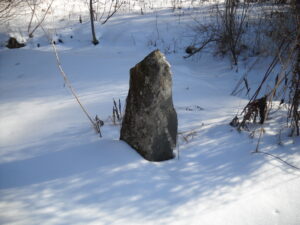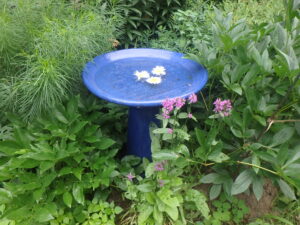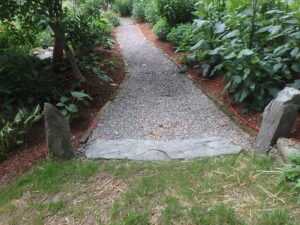It’s Time to Reflect on Our Gardens
Posted on Tuesday, April 13, 2021 · Leave a Comment
This is a good time to look carefully at your garden, and to decide what you might do to make it better. Spring is upon us, trees and shrubs are waking up in my garden, but perennials are still mostly dormant and woody plants are just beginning to leaf out. It is a good time to look at “the bones” of the garden and decide what needs to be done.

Standing stones are wonderful in winter
The bones of the garden are the trees, shrubs, stone walls, sculpture, water features and pathways. These are visible in winter, though often covered in snow. In summer they can become focal points, or almost disappear as flowering plants shout out for attention.
Each of us reacts to spaces a little differently. Some want an enclosed garden that is quiet and private. Others want a long view of the sea, a pond, or a distant mountain. If you are lucky, you might be able to divide your garden up so that you enjoy more than one type of garden: sunny, shaded, private or open to the view of passers-by. If you have just a city lot, you may have to choose just one kind of garden to focus on.
Making a garden private means creating visual barriers. You can do that overnight by hiring a company to put up a wooden 8-foot fence. Your neighbors may not like this and walls are generally monochromatic and boring. Of course you can then grow vines up them, or plant trees and shrubs in front of them, but plants take time to fill in and disguise the fence or wall. Still, if you have a new puppy or a bouncy four-year old child, you may opt for the immediate enclosure provided by fencing.

This garden gnome in his stone igloo that was sturdy and fun to build enhanced my garden for years
Alternatively, you can plant trees. There are advantages to this: trees get bigger and better every year. They provide habitat and food for birds, pollinators and all sorts of small animals. They reduce water runoff. And although some require occasional pruning, most of Mother Nature’s trees do just fine on their own. Some are fast growing, others will just inch along, holding place without shading the understory.
The street side of your house is important. What you show the world says something about you. If you plant a tall hedge, it can send a signal to others that you wish to remain undisturbed. If you have just lawn, it says you are not a gardener. If you plant beds and islands of color, you are saying, “Welcome, and enjoy!” Of course, lawns are the easiest to maintain, especially if you accept my mantra, “If it’s green and you can mow it, it’s a lawn.” I love a few dandelions, and love my clover which fixes atmospheric nitrogen into the soil – it’s free fertilizer.
Trees and shrubs are important on the front lawn as much as in the gardens behind the house. You can break up the straight lines of driveway and front walk. When thinking through your plans, take a garden hose and curve it around to define spaces. Create beds with bump-outs, and drive stakes to indicate where you might add trees, and use shorter stakes to indicate shrubs. And instead of lawn between the trees, imagine groundcovers. It will soften the look of your home, and invite birds and pollinators. You can keep some lawn, just reduce its footprint.
What other bones can you add to your property? Stone is wonderful in all its forms. The simplest stone additions are just boulders or tall, narrow standing stones. One and done. Stone walls are delightful, but expensive.
You can also build a cairn – a pile of stones similar to the markers seen on mountain trails above the tree line. The key, if piling up stones to create a pyramid or cairn, is to ensure that each stone is resting on two stones below it. And be careful that when you touch a stone it does not tumble. The earth does move a bit with the seasons, so building a sturdy structure is important.

A simple bluebird bath can add color and interest
Water features are nice, too. A simple birdbath can add interest and provide water for insects and birds. I have a blue ceramic birdbath that adds color and height to a flower bed – even though the birds seem to ignore it. I was told to put a stone in the water for them to perch on, but even that has not lured them in. Of course, I have a brook nearby, so that is probably their choice instead.
I love sculpture in the garden. One of my favorite sculpture gardens is the deCordova Sculpture Park and Museum in Lincoln, Massachusetts. It’s 20 miles outside of Boston and has 30 acres of gardens chock full of delightful art, and it’s worthy of a visit. A place like that might inspire you to make or buy some art. So long as it gives you pleasure, it’s worth garden space. Found metal objects can be turned into art – if you think outside the box.
Sculpturefest in Woodstock, Vermont is an annual outdoor exhibition of sculpture made by local artists and is always worthy of a visit. See more at
https://www.sculpturefest.org/

Our pea stone walkway keeps the garden neat
Pathways are important to gardens. They can keep your shoes out of mud and protect the soil from erosion. Flat stones are great, as are pea stone or small gravel. Chipped branches or bark mulch can be used for walkways, too. Pathways naturally lead one forward to other parts of the garden. Grassy paths are simple, and work well so long as they are not worn bare by too much foot traffic.
So go outside and do some planning – even if it is too early to do much now.






